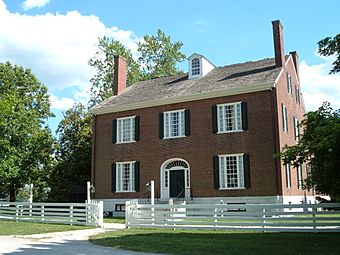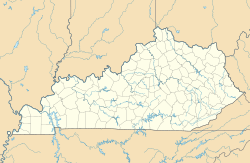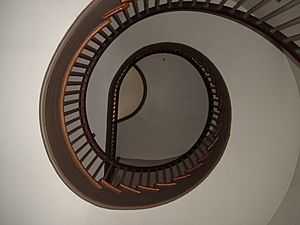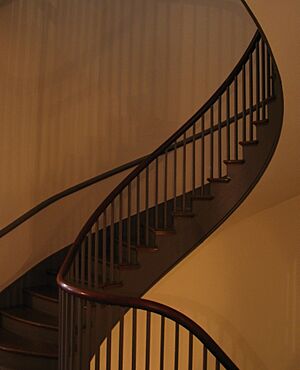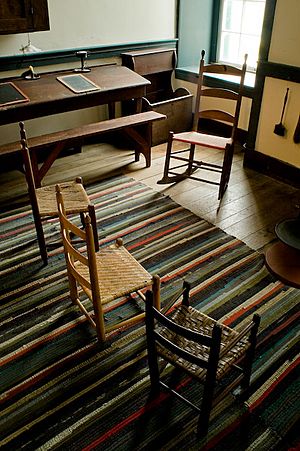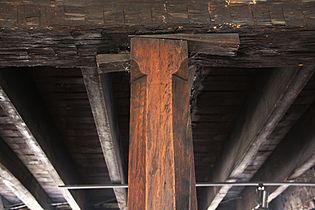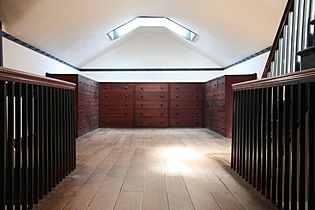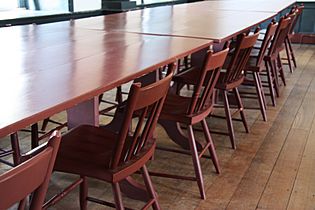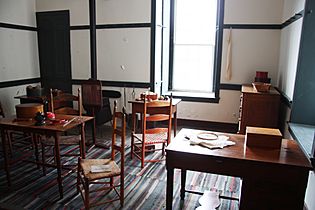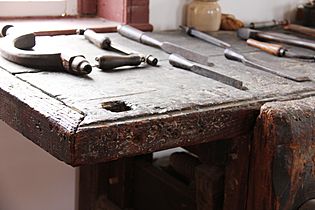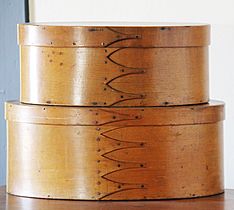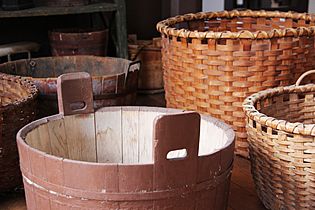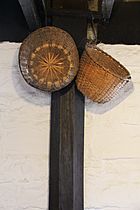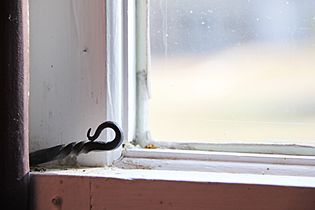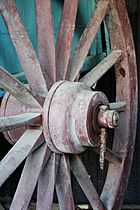Pleasant Hill, Kentucky facts for kids
Pleasant Hill, Kentucky, in the USA, was once home to a special religious group called the Shakers. This community was active from 1805 to 1910. Today, it is a National Historic Landmark. After a big effort to save and restore it starting in 1961, it has become a popular place for visitors.
The Shaker Village of Pleasant Hill, also known as Shakertown, is about 25 miles (40 km) southwest of Lexington. It is located in Kentucky's beautiful Bluegrass region.
Contents
The Story of Pleasant Hill
How Pleasant Hill Began
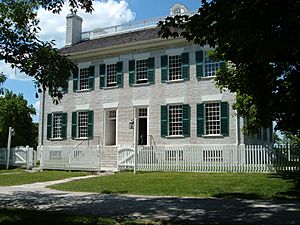
In the late 1700s and early 1800s, a big religious movement called the Second Great Awakening swept across America. Many people gathered for large outdoor meetings. Ministers would preach, and people would sing and dance. These events brought thousands together, especially in the Ohio Valley of Kentucky. They helped people feel connected in a time when many lived far apart.
The Shakers, a Christian group, were inspired by this religious excitement. They decided to send missionaries to Kentucky to find new followers. On January 1, 1805, three Shaker missionaries, John Meacham, Benjamin Seth Youngs, and Issachar Bates, began a long journey. They walked over a thousand miles to reach the western lands.
By August 1805, they had found a small group of people who believed in the teachings of Ann Lee. Ann Lee was born in England in 1736. She was part of a Quaker group known for their energetic worship, which led to the name "Shaking Quakers." After being imprisoned for her beliefs, she said she had a vision that she was the second coming of Christ.
When she was freed in 1772, she started a new religious group. People called them Shakers because of their dancing and movements during worship. Ann Lee taught that God was both male and female. She believed that since the Bible says God created humans "male and female" in His image, God must have both qualities.
Shakers believed that Ann Lee was the second coming of the messiah. They thought they were living in the "last days." Because of this, they believed everyone should live as brothers and sisters. They felt there was no longer a need to marry or have children. Instead, they lived together in shared communities.
Couples who joined the Shakers lived separately. Their young children and any orphans were raised in a special nursery. When children grew up, they could choose if they wanted to stay in the community. Many of the first Shaker followers in Kentucky had been part of the lively Cane Ridge Revival.
In December 1806, 44 new Shaker members signed an agreement. They promised to support each other and share all their property. They began living on a 140-acre farm owned by Elisha Thomas. This farm became the heart of the Pleasant Hill Shaker village. Soon, more people joined, and the community grew to 4,369 acres.
By 1812, the community had three main living groups: East, Center, and West. A fourth group, North, was set up for people who were thinking about joining. In 1814, 128 members signed a more formal agreement. This made Pleasant Hill like the main Shaker village in New Lebanon, New York.
Life and Success at Pleasant Hill
When the Kentucky Shakers started, they were not rich. But they were very skilled farmers. They made the most of their land and quickly became successful. Even people who didn't agree with their religion could see how well they did. In 1852, a visitor noted that Shaker products sold for much more than what other farmers received.
Their location was also perfect for selling their goods. By 1816, they regularly traveled by river to big cities like New Orleans to sell what they made.
The Pleasant Hill Shakers grew broom corn and made excellent flat brooms. These brooms sold for more than regular ones. They also grew fruit and sold it dried or as preserves. In one year, they sold over ten tons of preserves! Like many Shaker communities, they also grew and sold garden seeds.
By 1825, Pleasant Hill was a beautiful village. It had large stone and brick homes and workshops. There were green lawns and stone sidewalks. One visitor was impressed by their success and kindness. He called them "trafficking, humane, honest and thrifty people."
Over the years, they bought more land for orchards and fields. They built stone walls to fence their property. A visitor in 1857 said they had hired a man for 12 years just to build stone walls. He had built 40 miles of walls! Their buildings were large, strong, and well-made, with modern comforts.
The Pleasant Hill community was also known for its excellent animals. In 1838, a Shaker named John Bryant sold two Berkshire hogs for $500. In the 1850s, they had about 500 well-fed cattle. They even brought in special cows to improve their milk production. They used smart farming methods long before most other farmers. They also raised Saxony sheep for wool. Shaker sisters spun this wool into cloth for their own use.
The Pleasant Hill Shakers were also famous for their clever inventions. They had a municipal water system before many towns in their area. By 1825, they had water pumps in their kitchens. This made life easier for the sisters, who often had to carry water from a creek. Their mill had an elevator to move grain. They also had a machine to shell corn.
Shaker sisters even had machines powered by horses to help with laundry.
One of their barns had an upper floor for storing grain and hay. It also had a machine for chopping animal food. A clever railway system delivered food to the cattle.
Challenges During the Civil War
The location of the Kentucky Shakers caused problems during the American Civil War.
Even before the war, the Pleasant Hill Shakers faced difficulties. The Shaker religion believed in peace and was against slavery. While the Pleasant Hill members formally followed these rules, their neighbors had different views. In 1825, because of strong disagreements about slavery in the area, the Shakers faced challenges, and some of their buildings were damaged.
During the Civil War, Pleasant Hill was at risk. Although they supported the Union, their Southern location made them a target for some groups. They did not suffer as much damage as their sister community in South Union, Kentucky, but the war still hurt them.
The Civil War used up many of Pleasant Hill's resources. The Shakers fed thousands of soldiers who came asking for food. This happened especially around the time of the Battle of Perryville. Both armies "nearly ate [them] out of house and home." They also lost workers when some young Shaker men left to join the army.
After the war, it became harder to attract new members. The way society was changing made the Shaker way of life less appealing. Very few new people joined the Shakers during and after this time.
The Final Years
After the Civil War, the Kentucky Shaker communities faced many problems. They continued to take in orphans, but most left when they grew up. Some poor locals, called "Winter Shakers," would pretend to want to join the community during the cold months. They would stay for food and warmth but rarely helped out. More members also started leaving the community.
As the number of members dropped, the Shakers began closing some communities. They moved the remaining members into the villages that were still open. Pleasant Hill once had almost 500 members. By 1875, even with some new members from Sweden, it had less than half that number. In 1900, only 34 Shakers remained. The Pleasant Hill Shaker community officially closed in 1910.
The last Shaker member from Pleasant Hill was Mary Settles (1836–1923). She was happy to live long enough to see women get the right to vote. She planned to vote for the Democratic party on her first ballot. She often said that Shaker women had always had equal rights within their community.
Daily Life and Inventions
Many visitors to Pleasant Hill see the old buildings, crafts, and clothing. They might think the Shakers, like the Amish, avoided new technology. But this is not true! The Shakers were often inventors or among the first to use new tools and ideas.
For example, in the early 1830s, the Shakers at Pleasant Hill built a water tower on a high piece of land. A horse-drawn pump lifted water into the tower. From there, a system of pipes carried water to the kitchens, cellars, and wash houses. This is believed to be the first water tower system in Kentucky. In the wash houses, they built washing machines (also powered by horses) to make the hard work of washing clothes easier.
Music was a very important part of Shaker life. The community performed many songs, hymns, and anthems. Both men and women wrote these songs. One famous song is "Gentle Words," written by Polly M. Rupe in the 1860s. It includes a quote from the Bible (Matthew 7:12).
Saving Shakertown: A New Beginning
After the Shaker community closed in 1910, the property was used for different things. Elderly Shakers continued to live there until Mary Settles, the last Pleasant Hill Shaker, passed away in 1923.
The Meeting House, where the Shakers worshipped, was even turned into a garage for cars. Its strong wooden floor, built for dancing, was tough enough for vehicles. Later, it became a Baptist church.
After World War II, people in the area became interested in the old, crumbling village of Pleasant Hill. A famous writer and monk named Thomas Merton visited in 1959. He was fascinated by the quiet beauty of the place. He wrote about the "marvelous double winding stair" and the "quiet sunlight." He felt there was still "joy there... and simplicity."
Others shared his interest. In 1961, a group of citizens from Lexington started an effort to restore the property. By 1964, they formed a non-profit organization called the Friends of Pleasant Hill. They raised money and got a $2 million loan from the federal government to buy and restore the site. James Lowry Cogar, who had helped restore Colonial Williamsburg, was chosen to lead this big project.
Today, Shaker Village of Pleasant Hill has 34 original 19th-century buildings and 2,800 acres (1100 hectares) of farmland. It is known as "the largest historic community of its kind in America."
Images for kids


